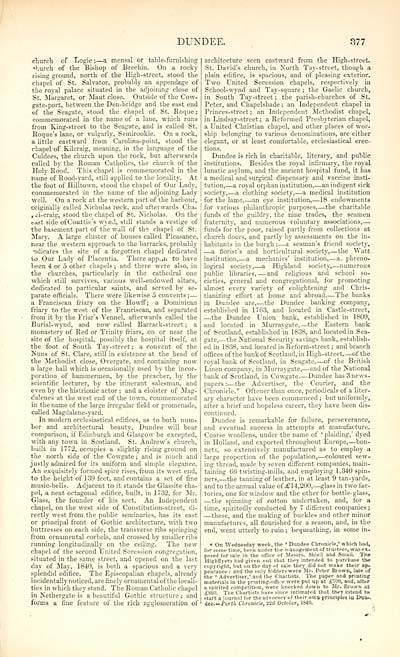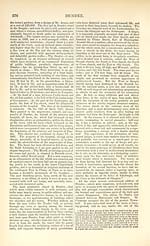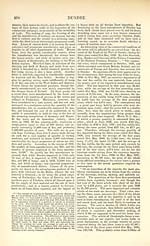Topographical, statistical, and historical gazetteer of Scotland > Volume 1
(461) Page 377
Download files
Complete book:
Individual page:
Thumbnail gallery: Grid view | List view

DUNDEE.
377
church of Xogie ; — a mensal or table-furnishing
•hurcu of the Bishop of Brechin. On a rocky
rising ground, north of the High-street, stood the
chapel of St. Salvator, probably an appendage of
the royal palace situated in the adjoining close of
St. Margaret, or Maut close. Outside of the Cow-
gate-port, between the Den-bridge and the east end
of the Seagate, stood the chapel of St, Roque ;
commemorated in the name of a lane, which runs
from King-street to the Seagate, and is called St.
Roque's lane, or vulgarly, Semirookie. On a rock,
a little eastward from Carolina-point, stood the
chapel of Kilcraig, meaning, in the language of the
Culdees, the church upon the rock, but afterwards
called by the Roman Catholics, the church of the
Holy Rood. This chapel is commemorated in the
name of Rood-yard, still applied to the locality. At
the foot of Hilltown, stood the chapel of Our Lady,
commemorated in the name of the adjoining Lady
well. On a rock at the western part of the harbour,
originally called Nicholas rock, and afterwards Cha-
,ei-craig, stood the chapel of St. Nicholas. On the
eitst side of Couttie's wynj, still stands a vestige of
the basement part of the wail of the chapel of St.
Mary. A large cluster of houses called Pleasance,
near the western approach to the barracks, probably
ndicates the site of a forgotten chapel dedicated
id Our Lady of Placentia. There app^ii to have
been 4 or 5 other chapels ; and there were also, in
the churches, particularly in the cathedral one
which still survives, various well-endowed altars,
dedicated to particular saints, and served by se-
parate officials. There were likewise 5 convents ; —
a Franciscan friary on the Howff; a Dominican
friary to the west of the Franciscan, and separated
from it by the Friar^s Vennel, afterwards called the
Burial- wynd, and now called Barrack-street; a
monastery of Red or Trinity friars, on or near the
site of the hospital, possibly the hospital itself, at
the foot of South Tay-street ; a convent of the
Nuns of St. Clare, still in existence at the head of
the Methodist close, Overgate, and containing now
a large hall which is occasionally used by the incor-
poration of hammermen, by the preacher, by the
scientific lecturer, by the itinerant salesman, and
even by the histrionic actor ; and a cloister of Mag-
dalenes at the west end of the town, commemorated
in the name of the large irregular field or promenade,
called Magdalene-yard.
In modern ecclesiastical edifices, as to both num-
ber and architectural beauty, Dundee will bear
comparison, if Edinburgh and Glasgow be excepted,
with any town in Scotland. St. Andrew's church,
built in 1772, occupies a slightly rising ground on
the north side of the Cowgate; and is much and
justly admired for its uniform and simple elegance.
An exquisitely formed spire rises, from its west end,
to the height of 139 feet, and contains a set of fine
music-bells. Adjacent to it stands the Glassite cha-
pel, a neat octagonal edifice, built, in 1 732, for Mr.
Glass, the founder of his sect. An Lidependent
chapel, on the west side of Constitution-street, di-
rectly west from the public seminaries, has its east
or principal front of Gothic architecture, with two
buttresses on each side, the transverse ribs springing
from ornamental corbels, and crossed by smaller ribs
running longitudinally on the ceiling. The new
chapel of the second United Secession congregation,
situated in the same street, and opened on the last
day of May, 1840, is both a spacious and a very-
splendid edifice. The Episcopalian chapels, already
incidentally noticed, are finely ornamental of the locali-
ties in which they stand. The Roman Catholic chapel
in Netbergate is a beautiful Gothic structure ; and
forms a fine feature of the rich agglomeration of
architecture seen eastward from the High-street.
St. David's church, in North Tay-street, though a
plain edifice, is spacious, and of pleasing exterior.
Two ITnited Secession chapels, respectively in
School-wvnd and Tay-square ; the Gaelic church,
in South Tay-street ; the parish-churches of St.
Peter, and Chapelshade ; an Independent chapel in
Princes-street ; an Independent Methodist chapel,
in Lindsay-street; a Reformed Presbyterian chapel,
a United Christian chapel, and other places of wor-
ship belonging to various denominations, are either
elegant, or at least comfortable, ecclesiastical erec-
tions.
Dundee is rich in charitable, literary, and public
institutions. Besides the royal infirmary, the royal
lunatic asylum, and the ancient hospital fund, it has
a medical and surgical dispensary and vaccine insti-
tution, — a royal orphan institution, — an indigent sick
society, — a clothing society, — a medical institution
for the lame, — an eye institution, — 18 endowments
for various philanthropic purposes, — the charitable
funds of the guildry, the nine trades, the seamen
fraternity, and numerous voluntary associations, —
funds for the poor, raised partly from collections at
church doors, and partly by assessments on the in-
habitants in the burgh ; — a seaman's friend society,
— a florist's and horticultural society, — the Watt
institution, — a mechanics' institution, — a. phreno-
logical society, — a Highland society, — numerous
public libraries, — and religious and school so-
cieties, general and congregational, for promoting
almost every variety of enlightening and Chris-
tianizing effort at home and abroad The banks
in Dundee are, — the Dundee banking company,
established in 1763, and located in Castle-street,
— the Dundee Union bank, established in 1S09,
and located in Murraygate, — the Eastern bank
of Scotland, established in 183S, and located in Sea-
gate, — the National Security savings bank, establish-
ed in 1838, and located in Reform-street ; and branch
offices of the bank of Scotland, in High-street, — of the
royal bank of Scotland, in Seagate, — of the British
Linen company, in Murraygate, — and of the National
bank of Scotland, in Cowgate. — Dundee has 3 news-
papers: — the Advertiser, the Courier, and the
Chronicle.* Oftener than once, periodicals of a liter-
ary character have been commenced ; but uniformly,
after a brief and hopeless career, they have been dis-
continued.
Dundee is remarkable for failure, perseverance,
and eventual success in attempts at manufacture.
Coarse woollens, under the name of ' plaiding,' dyed
in Holland, and exported throughout Europe, — bon-
nets, so extensively manufactured as to employ a
large proportion of the population, — coloured sew-
ing thread, made by seven different companies, main-
taining 66 twisting-mills, and employing 1,340 spin-
ners, — the tanning of leather, in at least 9 tan-yards,
and to the annual value of £14,200, — glass in two fac-
tories, one for window and the other for bottle-glass,
— the spinning of cotton undertaken, and, for a
time, spiritedly conducted by 7 different companies ;
— these, and the making of buckles and other minor
manufactures, all flourished for a season, and, in the
end, went utterly to ruin ; bequeathing, in some in-
* Oo Wednesday week, the * Dundee Chronicle,' which had,
for some time, been under the management of trustees, was ex-
posed for sale in the office of Messrs. Shiell and Small. The
Highflyers had given out that they intended to purchase the
copyright, but on the day of sale they did not make their ap-
pearance : and the only bidders were Mr. Peter Brown, late of
the ' Advertiser,' and the Chartists. The paper and printing
materials in the printing-office were put up at £700, and, after
a spirited competition, were knocked down to Mr. Brown at
£S20. The Chartists have since intimated that they intend to
"tart a iounial for the advocacy of their own principles in Dun^
dee Perth Chronicle, X2d October, 1S40.
377
church of Xogie ; — a mensal or table-furnishing
•hurcu of the Bishop of Brechin. On a rocky
rising ground, north of the High-street, stood the
chapel of St. Salvator, probably an appendage of
the royal palace situated in the adjoining close of
St. Margaret, or Maut close. Outside of the Cow-
gate-port, between the Den-bridge and the east end
of the Seagate, stood the chapel of St, Roque ;
commemorated in the name of a lane, which runs
from King-street to the Seagate, and is called St.
Roque's lane, or vulgarly, Semirookie. On a rock,
a little eastward from Carolina-point, stood the
chapel of Kilcraig, meaning, in the language of the
Culdees, the church upon the rock, but afterwards
called by the Roman Catholics, the church of the
Holy Rood. This chapel is commemorated in the
name of Rood-yard, still applied to the locality. At
the foot of Hilltown, stood the chapel of Our Lady,
commemorated in the name of the adjoining Lady
well. On a rock at the western part of the harbour,
originally called Nicholas rock, and afterwards Cha-
,ei-craig, stood the chapel of St. Nicholas. On the
eitst side of Couttie's wynj, still stands a vestige of
the basement part of the wail of the chapel of St.
Mary. A large cluster of houses called Pleasance,
near the western approach to the barracks, probably
ndicates the site of a forgotten chapel dedicated
id Our Lady of Placentia. There app^ii to have
been 4 or 5 other chapels ; and there were also, in
the churches, particularly in the cathedral one
which still survives, various well-endowed altars,
dedicated to particular saints, and served by se-
parate officials. There were likewise 5 convents ; —
a Franciscan friary on the Howff; a Dominican
friary to the west of the Franciscan, and separated
from it by the Friar^s Vennel, afterwards called the
Burial- wynd, and now called Barrack-street; a
monastery of Red or Trinity friars, on or near the
site of the hospital, possibly the hospital itself, at
the foot of South Tay-street ; a convent of the
Nuns of St. Clare, still in existence at the head of
the Methodist close, Overgate, and containing now
a large hall which is occasionally used by the incor-
poration of hammermen, by the preacher, by the
scientific lecturer, by the itinerant salesman, and
even by the histrionic actor ; and a cloister of Mag-
dalenes at the west end of the town, commemorated
in the name of the large irregular field or promenade,
called Magdalene-yard.
In modern ecclesiastical edifices, as to both num-
ber and architectural beauty, Dundee will bear
comparison, if Edinburgh and Glasgow be excepted,
with any town in Scotland. St. Andrew's church,
built in 1772, occupies a slightly rising ground on
the north side of the Cowgate; and is much and
justly admired for its uniform and simple elegance.
An exquisitely formed spire rises, from its west end,
to the height of 139 feet, and contains a set of fine
music-bells. Adjacent to it stands the Glassite cha-
pel, a neat octagonal edifice, built, in 1 732, for Mr.
Glass, the founder of his sect. An Lidependent
chapel, on the west side of Constitution-street, di-
rectly west from the public seminaries, has its east
or principal front of Gothic architecture, with two
buttresses on each side, the transverse ribs springing
from ornamental corbels, and crossed by smaller ribs
running longitudinally on the ceiling. The new
chapel of the second United Secession congregation,
situated in the same street, and opened on the last
day of May, 1840, is both a spacious and a very-
splendid edifice. The Episcopalian chapels, already
incidentally noticed, are finely ornamental of the locali-
ties in which they stand. The Roman Catholic chapel
in Netbergate is a beautiful Gothic structure ; and
forms a fine feature of the rich agglomeration of
architecture seen eastward from the High-street.
St. David's church, in North Tay-street, though a
plain edifice, is spacious, and of pleasing exterior.
Two ITnited Secession chapels, respectively in
School-wvnd and Tay-square ; the Gaelic church,
in South Tay-street ; the parish-churches of St.
Peter, and Chapelshade ; an Independent chapel in
Princes-street ; an Independent Methodist chapel,
in Lindsay-street; a Reformed Presbyterian chapel,
a United Christian chapel, and other places of wor-
ship belonging to various denominations, are either
elegant, or at least comfortable, ecclesiastical erec-
tions.
Dundee is rich in charitable, literary, and public
institutions. Besides the royal infirmary, the royal
lunatic asylum, and the ancient hospital fund, it has
a medical and surgical dispensary and vaccine insti-
tution, — a royal orphan institution, — an indigent sick
society, — a clothing society, — a medical institution
for the lame, — an eye institution, — 18 endowments
for various philanthropic purposes, — the charitable
funds of the guildry, the nine trades, the seamen
fraternity, and numerous voluntary associations, —
funds for the poor, raised partly from collections at
church doors, and partly by assessments on the in-
habitants in the burgh ; — a seaman's friend society,
— a florist's and horticultural society, — the Watt
institution, — a mechanics' institution, — a. phreno-
logical society, — a Highland society, — numerous
public libraries, — and religious and school so-
cieties, general and congregational, for promoting
almost every variety of enlightening and Chris-
tianizing effort at home and abroad The banks
in Dundee are, — the Dundee banking company,
established in 1763, and located in Castle-street,
— the Dundee Union bank, established in 1S09,
and located in Murraygate, — the Eastern bank
of Scotland, established in 183S, and located in Sea-
gate, — the National Security savings bank, establish-
ed in 1838, and located in Reform-street ; and branch
offices of the bank of Scotland, in High-street, — of the
royal bank of Scotland, in Seagate, — of the British
Linen company, in Murraygate, — and of the National
bank of Scotland, in Cowgate. — Dundee has 3 news-
papers: — the Advertiser, the Courier, and the
Chronicle.* Oftener than once, periodicals of a liter-
ary character have been commenced ; but uniformly,
after a brief and hopeless career, they have been dis-
continued.
Dundee is remarkable for failure, perseverance,
and eventual success in attempts at manufacture.
Coarse woollens, under the name of ' plaiding,' dyed
in Holland, and exported throughout Europe, — bon-
nets, so extensively manufactured as to employ a
large proportion of the population, — coloured sew-
ing thread, made by seven different companies, main-
taining 66 twisting-mills, and employing 1,340 spin-
ners, — the tanning of leather, in at least 9 tan-yards,
and to the annual value of £14,200, — glass in two fac-
tories, one for window and the other for bottle-glass,
— the spinning of cotton undertaken, and, for a
time, spiritedly conducted by 7 different companies ;
— these, and the making of buckles and other minor
manufactures, all flourished for a season, and, in the
end, went utterly to ruin ; bequeathing, in some in-
* Oo Wednesday week, the * Dundee Chronicle,' which had,
for some time, been under the management of trustees, was ex-
posed for sale in the office of Messrs. Shiell and Small. The
Highflyers had given out that they intended to purchase the
copyright, but on the day of sale they did not make their ap-
pearance : and the only bidders were Mr. Peter Brown, late of
the ' Advertiser,' and the Chartists. The paper and printing
materials in the printing-office were put up at £700, and, after
a spirited competition, were knocked down to Mr. Brown at
£S20. The Chartists have since intimated that they intend to
"tart a iounial for the advocacy of their own principles in Dun^
dee Perth Chronicle, X2d October, 1S40.
Set display mode to: Large image | Transcription
Images and transcriptions on this page, including medium image downloads, may be used under the Creative Commons Attribution 4.0 International Licence unless otherwise stated. ![]()
| Gazetteers of Scotland, 1803-1901 > Topographical, statistical, and historical gazetteer of Scotland > Volume 1 > (461) Page 377 |
|---|
| Permanent URL | https://digital.nls.uk/97443078 |
|---|
| Description | Volume first. A-H. |
|---|---|
| Attribution and copyright: |
|

